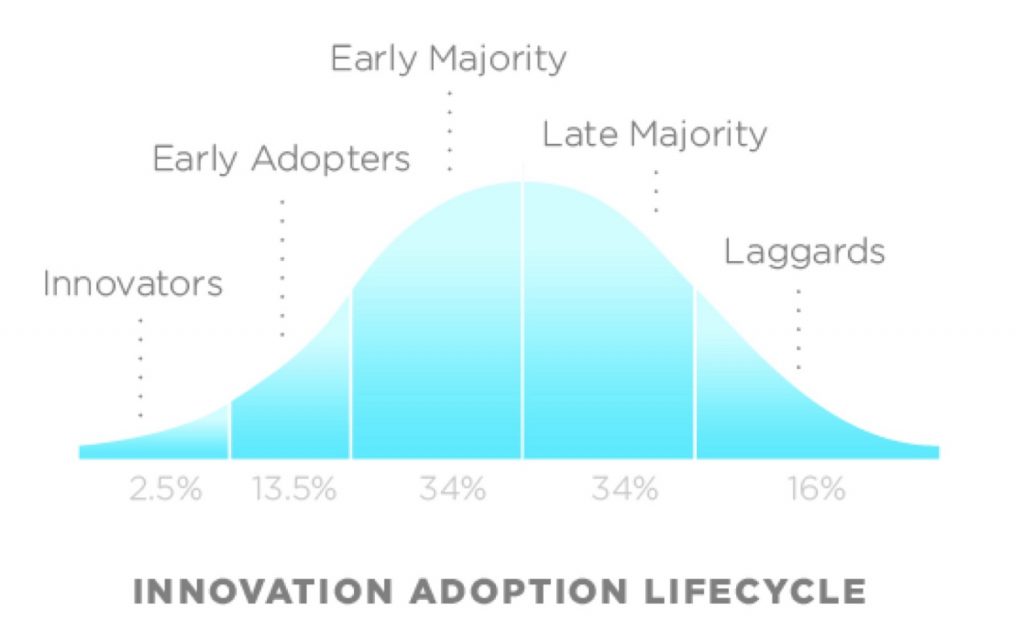The Early Adopter is a highly sought after group of digital influencers. Marketing teams with new products or services – from eBook readers to hybrid automobiles to new iOS Apps – often target Early Adopters in order to gain their acceptance first, primarily because they are significant trendsetters within their particular fields of interest. But what psychological drivers motivate the EA to try new things? And how can they best be targeted to adopt and spread the word to the general population?
The spread of products and ideas through a culture has been the subject of considerable study, beginning as far back as 1890, but the landmark work of Everett Rogers, in his 1962 book Diffusion of Innovations is really the foundation of the modern thinking about how ideas and products spread.
Rogers’ famous distribution curve illustrates the spread of population segments and their relative size in a clear, conscise view of the landscape.

Innovators on the far left of the bell curve, are the originators, the inventors, and they make up 2.5% of the overall population. In the 21st Century, these individuals are the incubators, start-ups, and thought leaders for change and innovation. The Early Adopters are the influencers early in the bell curve, who test new products and ideas, and become the influencers that drive subsequent phases of adoption. If EAs like something, they validate it for the more cautious Early Adopters of the next phase, which then ignites the products adoption into the mainstream. Early Adopters are 13% of the overall population, and they are the source of most of the trends and coolness factor marketers strive to be associated with.
Early Adopters are only 13% of the population.
The line between Early Adopter and Early Majority is the toughest leap of the entire curve, as the product or idea must pass through the gates of the Early Adopter testing, and overcome the initial skepticism of the Early Majority to find mass market acceptance.
Geoffrey Moore’s book Crossing the Chasm: Marketing and Selling Disruptive Products to Mainstream Customers addresses this leap-point specifically. Moore concludes that each of the segments outlined by Rogers need to be targeted and messaged individually, working your way from left to right in stages. So it behooves us to study the EAs carefully, and discern the best possible way for them to learn about and experience a new product or service.
All of the above research is extremely informative to designing and executing social media campaigns for new products or services, as it describes the stages of messaging required to launch something new, and have it spread through communications channels to the mass market.
Early Adopter Psychology
Early Adopters, like all of us, are driven in large part by one of three basic lifestyle goals: career, family, or personal entertainment. However, what sets them apart from the general population are psychological drivers behind their actions – the motives underlying the progress to these goals. Early Adopters are driven by three main motivations: Information, Novelty, and Status.
Early Adopters are driven by three main motivations: Information, Novelty, and Status.
To be an early adopter you have to be an information gatherer, and as such they are not driven by irrational urges to have the cool shiny new object, EA’s are rational researchers first, and emotional impulse buyers second. All new things are unknown, and the EA has set themselves up to learn about things before anyone else. And risk they are taking in buying something first, is mitigated by the fact that they’ve done their research on the product well ahead. 75% of EAs shop around for purchases (compared to roughly half of everyone else) and they are twice as likely to use comparison shopping sites.
A couple of great reads on the subject:
Ad Age Insights, March 2010.
Forrester Research, Nov. 2009.
The second driver is novelty. By definition, EA’s are risk takers. Everything new has the risk of failure, and by purchasing something new the financial risks are obvious. Many EA’s have a personal entertainment goal in mind when the buy something new, and their attitudes reflect this quest for novelty. According to the Forrester research survey, EA’s are 72% more likely to say “I am always willing to try and do new things” than the laggards at the right end of the bell curve. Those EA’s in search of entertainment tend to be constantly looking for what’s new. I think we all know someone who is the first person to find the next big band, well before their music makes to the airwaves. This is a good example of a novelty seeking EA.
Lastly, status is a strong psychological driver for EAs. EAs choose products that represent them in the world, and they are two to five times more likely to select status as a motivation. The tremendous success of iPhone and iPads, and the ongoing buzz around every update, is driven by the status that EAs derive from being the first blogger to report on a new screen size, or the position of the Facetime camera – and no doubt being seen using the newest device amongst their peers.
Conclusion
Marketers who have a new product, particularly innovative technical devices and services, should plan their launches around a seed campaign to EA’s with exclusivity for the most influential voices in social media. Apple, with one of the most secure campuses on the planet, does seed small pieces of information through select channels, in order to build buzz for their latest releases. Timing these announcements, and letting hand-chosen influencers into the inner circle, are very effective tactics ahead of a major launch, and understanding the psychological drivers behind the EA’s motivations are a major factor in ensuring success further down the bell curve.



